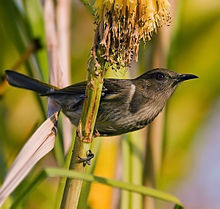
Back Heuningvreters Afrikaans آكلات العسل Arabic آكلات العسل ARZ Meliphagidae AST Proklano (Meliphagidae) AVK Медоядови Bulgarian Meliphagidae Breton Menjamels Catalan Meliphagidae CEB Kystráčkovití Czech
| Honeyeaters | |
|---|---|

| |
| Female crescent honeyeater (Phylidonyris pyrrhopterus) | |
| Scientific classification | |
| Domain: | Eukaryota |
| Kingdom: | Animalia |
| Phylum: | Chordata |
| Class: | Aves |
| Order: | Passeriformes |
| Superfamily: | Meliphagoidea |
| Family: | Meliphagidae Vigors, 1825 |
A honeyeater is one of a large family of small to medium-sized birds which feed on nectar. They are most common in Australia and New Guinea, but are also found in New Zealand, the Pacific islands as far east as Samoa and Tonga, and the islands to the north and west of New Guinea. Bali, on the other side of the Wallace Line, has a single species.
Honeyeaters and the Australian chats (Epthianura) make up the family Meliphagidae. In total there are 182 species in 42 genera.[2] About half of them live in Australia, and many of the others are from New Guinea. Although honeyeaters look and behave much like other nectar-feeding birds around the world (such as the sunbirds and flowerpeckers), they are not related.
There is an important partnership between honeyeaters and Australian flowering plants. A great many Australian plants are fertilised by honeyeaters, particularly the Proteaceae, Myrtaceae, and Epacridaceae. It is known that the honeyeaters are important in New Zealand as well, and scientists believe they are just as important in other areas.
- ↑ Sibley, C.G. and Monroe, B.L. Jr. (1990). Distribution and Taxonomy of Birds of the World. New Haven: Yale University Press. ISBN 0-300-04969-2.
- ↑ as listed in Sibley & Monroe 1990.